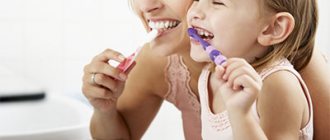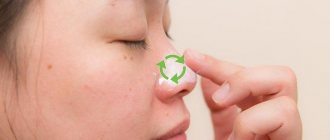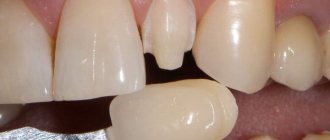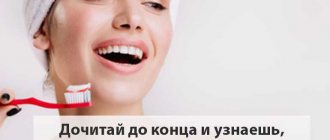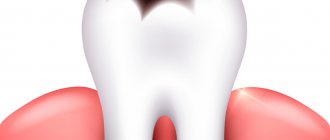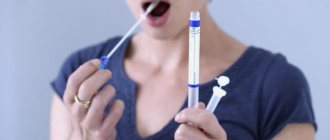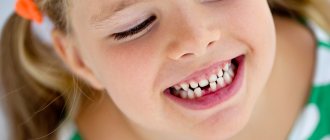17.03.2018
What kind of TOOTHPASTE can you “eat” and in what cases is it better to consult a doctor!
“Most toothpaste is made up of fluoride, a fine abrasive, and a foaming agent. Often parents are AFRAID of taking toothpaste for children with fluoride and take it without it at all. In order to clean your teeth well, you need to take a paste with a fluoride concentration starting with a dosage of 500 ppm. It is important for your child to choose children’s toothpaste according to his age! Fluoride helps prevent tooth decay by maintaining strong tooth enamel and inhibiting the growth of bacteria in plaque. There is no need to be afraid of fluoride itself!” - says pediatric dentist, member of the Association of Preventive and Pediatric Dentistry Yousefian Ehsan. (Shortcut?) To protect children from the dangers of fluoride in toothpaste, parents should treat toothpaste like any other harmful chemical and keep it locked up when not in use. Doctors recommend supervising children under 6 years of age when brushing their teeth and reminding them to spit out the toothpaste rather than swallow it. Parents should also teach children to use toothpaste no larger than a pea-sized amount. Infants younger than 6 months should never be exposed to fluoride toothpaste.
Prevention
- A healthy lifestyle and daily oral care using personal hygiene products will help prevent the development of gumboil. For cleaning, use a medium-hard brush.
- After each meal, it is recommended to rinse your mouth with a special mouthwash or use dental floss. Instead of a pharmaceutical composition, it is allowed to use an aqueous solution of food salt, sea salt or an alcoholic tincture of propolis.
- Do not use non-sterile objects as toothpicks. Such actions lead to mechanical injuries and infection.
- Periodic professional dental cleaning helps remove stone, which provokes the development of inflammation of the gums with pus.
- The daily diet must be supplemented with fresh vegetables and fruits. Apples, carrots and other solid plant foods cleanse plaque from enamel and strengthen teeth.
It is also important to treat dental defects immediately and undergo regular clinical examinations at least twice a year. It is much easier to prevent dental disease than to treat its negative consequences. You should be attentive to your health and not ignore the warning signals that your body gives.
Note to parents: features of children's toothpastes
Parents should understand that toothpastes have a broad classification, and each of these types will be recommended for patients of a certain age or for certain diseases of the oral cavity. For children under one year of age, it is recommended to use only gel toothpastes that are not abrasive and contain enzymes as a cleaning component. Therefore, they have a pleasant milky taste and are free of harmful components that can cause trouble for the baby.
For children over one year old, pastes with a low level of abrasiveness are also recommended, but from the class of therapeutic and prophylactic, and not hygienic.
The composition of therapeutic and prophylactic pastes contains calcium, phosphorus, and fluorine. These microelements saturate the enamel with minerals and strengthen it. Children's pastes that are age-appropriate are safe even when swallowed; their components are broken down by the body's defenses and safely eliminated.
In case of inflammation of the gums, as well as in adolescence, children should use therapeutic and prophylactic pastes, which contain medicinal plants with anti-inflammatory properties.
Dangerous additives
Saccharin is a non-hazardous substance that helps manufacturers make the taste of pasta more pleasant and soft. However, sugar can also negatively affect the condition of the oral cavity, because, as is known, sweets provoke the development of bacteria and can lead to the gradual destruction of hard tissues.
Glycerin is a necessary additive that prevents toothpaste from quickly hardening and drying out even when opened. Unfortunately, the substance can cause digestive problems. Another component is paraffin. It is necessary to achieve the thickness and viscosity of the product. Large amounts of this substance in the body can lead to severe vomiting or constipation.
Is menthol included in toothpastes dangerous? Unfortunately, yes, it can negatively affect the functioning of the human heart and blood vessels, while it freshens breath very well. Formaldehyde is necessary to resist dangerous microbes, however, frequent use of pastes containing it, and especially their entry into the body when swallowed, can lead to vision problems and the development of pathological processes in the liver and kidneys.
How to properly teach your child not to swallow toothpaste
The first and main requirement is not to scare. You can’t say that “if you swallow it, your tummy will hurt.” Such words simultaneously evoke fear and curiosity to “try.” And even if it has never occurred to the baby to swallow the mixture, he will definitely do it.
The best thing is to lead by example. Brush your teeth together, encourage them with the words “you’re an adult now, so don’t forget to spit out the toothpaste...”, etc. Psychologists recommend teaching your child to spit out toothpaste at the age of 2.5-3 years. During this period, the child is already socially adapted and can understand the requirements and prohibitions. In addition, the need for the use of therapeutic and prophylactic toothpastes arises at approximately the age of 4 years. So parents will have a whole year to teach their child not only how to properly brush their teeth, but also how to spit toothpaste.
Types of dental abscess
Pyogenic bacteria enter healthy gum tissue through the bloodstream or due to mechanical damage. An abscess appears in the area of the affected element. When the abscess matures, the mucous membrane acquires a bluish tint, and a whitish spot or characteristic bubble appears. With its rupture, a fistula is formed in the periodontium, through which the contents flow out. This phenomenon does not lead to the disappearance of the problem, the inflammation remains. The pathology is indicated by the flow of pus from the gums when pressing on the affected area. There are several types of abscess:
Read also: Cargo Pants for Men
- Desnevoy. The lesion is on the surface of the soft membrane and interdental papillae. The cause of infiltration is associated with the ingress of food debris and mechanical injuries. If detected early, it responds well to treatment.
- Periapical. A common type of pathology that develops as a result of untreated carious lesions or periodontitis. Infection of the dental root system leads to the accumulation of exudate in the upper part of the root. When immunity decreases, the periosteum of the unit and the mucous membrane are affected, a fistula is formed, purulent sacs appear above the gum, and pus is released.
- Periodontal. The infiltrate develops inside the gum tissue. Infected contents accumulate in the mucous membrane, forming a protrusion in the periodontal pocket. Due to the lack of a channel for fluid to flow out, damage occurs to the bone and soft tissue surrounding the diseased element. There is a high probability of developing periodontitis.
- Pericoronal. The pathological process is characteristic of erupting units. Bacteria and food debris fall under the “hood” of the mucous membrane. As a result, pus accumulates above the tooth, the gums swell and cause pain. The disease is dangerous due to complications: swelling of the neck, angina pectoris.
- Periodontal-endodontic. Infectious damage to the pulp and periodontal tissues occurs. There is a risk of periodontitis.
Flux is characterized by several stages of development, which have characteristic manifestations:
- Serous. Lightning current. The inside of the cheek and mucous membranes swell within a couple of days.
- Purulent. Continuous, debilitating, throbbing pain in the unit. Redness and swelling of the mucous membrane. Hyperthermia.
- Diffuse. Swelling and soreness of the entire surface of the oral cavity, affecting the nose, lips, and outer cheeks.
- Chronic. Gradual progression over months or years. Long-term remissions are followed by relapses. As the swelling decreases, the inflamed areas remain firm.
Toothpastes with various inclusions
To stimulate even greater interest in brushing children's teeth, various plastic inclusions are introduced into toothpastes: stars, multi-colored balls, plates, etc. Such inclusions introduced into toothpastes were considered safe. But dentists are beginning to sound the alarm, claiming that oral problems are related to hygiene problems.
These particles, made of polyethylene, cannot biodegrade, but can get stuck in the tiny gaps between teeth and gums. In addition, such particles not only get stuck between the teeth, but can trap bacteria, which can ultimately cause gum inflammation and the development of tooth decay.
The alarm was first raised by Trish Whopravan, a dental hygienist from Texas. This wave has led to numerous studies that have shown that such inclusions do more harm than good. After published studies, most companies stopped using such toothpastes by 2016.
What to do if a child ate adult pasta
Adult products contain fluoride. They are dangerous when ingested in large quantities into the gastrointestinal tract. Cause the following negative reactions:
- intoxication with increased body temperature;
- irritation and inflammation of the mucous membrane;
- profuse diarrhea with risk of dehydration.
Parents should give the child a sorbent by immediately going to the hospital. If the doctor sees toxins in the composition, he will prescribe gastric lavage. Additionally, therapy is carried out to replenish the lack of fluid caused by diarrhea. Parents should not give other medications themselves.
Note! The pediatrician will recommend staying in the hospital for 1-2 days after swallowing the substance to eliminate the risk of adverse reactions. If they appear, additional therapy is prescribed.
Swallowing toothpaste in small quantities does not lead to disruption of body functions. But if a child or adult has swallowed a large amount of the product, consult a doctor. The paste can cause serious harm to the gastrointestinal tract. To eliminate the risk for young children, consult a dentist to choose a product that contains only natural ingredients.
Toothpastes for children - dangerous or not?
All formulations marked “from 0 to 3 years” are completely safe and even if a certain amount of the mixture is swallowed there will be no particular harm. There are no medicinal ingredients or preservatives in toothpastes for children. Natural formulations have a limited shelf life - after opening, the tube can be stored for no more than 30 days, and it should be kept in the refrigerator.
Negative consequences from swallowing the toothpaste by a child occur in three cases:
- The child uses a composition that has expired.
- There is an allergy to the components of the drug.
- The child ate too much toothpaste.
The concept of “a lot” is a volume of more than a pea. When teaching your child about hygiene, parents should show the amount of toothpaste that is needed for cleaning. It should be the size of a baby’s little fingernail (pea-sized). The problem arises due to the pleasant aroma and taste of the toothpaste - kids are not averse to eating the entire tube. To avoid this, store the composition in the refrigerator.
The consequences of excessive use of toothpaste by a child are indigestion and allergies such as urticaria.
Features of toothpaste for adults
Children's toothpaste is used up to 3 years of age, then children are transferred to more aggressive formulations with medicinal components. Therapeutic and prophylactic compositions are necessary for thoroughly cleaning teeth from plaque and stone. And such pastes, when eaten, can cause poisoning, headaches, intestinal dysbiosis, etc.
It is best to replace children's toothpaste with adult toothpaste after the baby learns to carefully spit out the remaining mixture.
Tags
Dental restoration, dental imaging, dental tomography, dental implantation, tooth extraction, wisdom tooth removal, dental plaque removal, teeth polishing, teeth whitening, zoom, teeth whitening, Amazing PROSTHETICS, dental prosthetics, treatment of caries, treatment of pulpitis, treatment of periodontal disease, treatment of periodontitis, treatment of periodontitis, treatment schemes. Treatment of caries Treatment of pulpitis Treatment of mobility Treatment of periodontitis
prostheticstreatmentmoscowpricesarticlesandhelpimplantationclinicservicescariesquestionssymptomstimerecordpatientemergencyreviewsfirstcontactspolicysignupresponsemedicalpromotionsbracesiswhiteningorthodonticssurgerydepartmentsdiseasepersonaldatadetailednewsdiagnosticshoursyourveneersinstallationcenter
